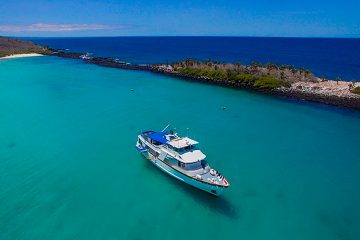4-Night Cruise
Tuesday – Saturday
Day 1
Tuesday AM: Arrival to Baltra Island Airport. Reception and Assistance at the airport by our members and transportation to our first visitor site.
Tuesday PM: Charles Darwin Research Station, Santa Cruz
The Fausto Llerena Giant Tortoise Breeding Center is managed by the Galapagos National Park Service and biologists from the Charles Darwin Research Station. The purpose of the center, named for a legendary park ranger, is to raise Galapagos tortoise hatchlings in a protected environment. When the tortoises are large enough to fend for themselves, they are released into the wild.
The program has been a great success and in recent years hundreds of young tortoises have been released on several islands. You will see different sub-species of tortoises in various species of development, from tiny young ones smaller than your fist to fully-grown behemoths lumbering about their enclosures. Your guide will accompany you and provide information about the programs and facilities.
The breeding center is located at the Charles Darwin Research Station, just outside of the town of Puerto Ayora. In addition to the tortoises, you may see finches, warblers and other birds in and around the tall tree cacti, and tiny lava lizards scurrying about underfoot.
After visiting the Research Station, passengers will be taken to the Puerto Ayora pier to board the M/C Elite.










 WhatsApp us
WhatsApp us